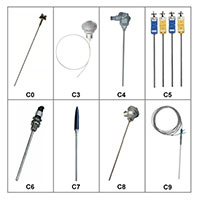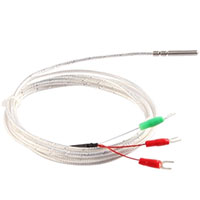Temperature Sensor Buying Guide
Temperature sensor is a sensor that senses temperature and converts it into a usable output signal. It is the core part of the temperature measuring instrument. According to the measurement method, there are two types of temperature sensor: contact sensor and non-contact sensor. And according to the characteristics of sensor materials and electronic components, it falls into two categories: thermal resistance and thermocouple.
Temperature is probably the most measured quantity in industry. Its accuracy and reliability often have a significant impact on the efficient operation and safety of a facility. In industrial facilities, more than 90% or more of temperature monitoring is done by thermocouple and resistance thermal detector (RTD). Selecting the most suitable sensor type can improve the accuracy, repeatability and stability of temperature measurement, and can reduce operating and maintenance costs.
ATO offers you different kinds of thermocouples and RTD sensors. When you need to buy a temperature sensor, we'll cover every detail to help you make the most economical and practical decision.
Thermocouple
 Thermocouple is mainly used in temperature measurement for kilns, gas turbine exhaust, diesel engines and other industrial equipments. It is also domestic appliance. Thermocouples serve as the temperature sensors of thermostats in offices or at home, and also as flame sensors in safety devices for gas-powered appliances. A thermocouple consists of two dissimilar electrical conductors forming an electrical junction. A thermocouple produces a temperature-dependent voltage as a result of the Seebeck effect, and this voltage can be interpreted to measure temperature.
Thermocouple is mainly used in temperature measurement for kilns, gas turbine exhaust, diesel engines and other industrial equipments. It is also domestic appliance. Thermocouples serve as the temperature sensors of thermostats in offices or at home, and also as flame sensors in safety devices for gas-powered appliances. A thermocouple consists of two dissimilar electrical conductors forming an electrical junction. A thermocouple produces a temperature-dependent voltage as a result of the Seebeck effect, and this voltage can be interpreted to measure temperature.
The types of thermocouples correspond to different electrical junctions. Each type has its measuring range, which are shown in the following table for you to choose from and purchase.
| Type of Thermocouple | Price | Composition | Temperature Range |
| T Type | $49.23 | copper / constantan | -250°C to 400°C |
| J Type | $68.92 | iron / constantan | -180°C to 750°C |
| E Type | $46.15 | chromel / constantan | -40°C to 900°C |
| K Type | $46.15 | chromel / alumel | -180°C to 1,200°C |
| S Type | $524.92 | platinum-rhodium (10%) / platinum | 0°C to 1,700°C |
| R Type | $1,031.92 | platinum-rhodium (13%) / platinum | 0°C to 1,700°C |
| B Type | $524.92 | platinum-rhodium (30%) / platinum-rhodium (6%) | 0°C to 1,800°C |
| N Type | $56.92 | nicrosil / nisil | -270°C to 1,280°C |
RTD sensor
 Resistance thermometer is also called resistance temperature detector (RTD). The resistance of the RTD will increase as the temperature increases and decrease as the temperature decreases, so RTD is commonly known as thermal resistance. The RTD wire is a pure material, typically platinum, nickel, or copper; each has different range. Compared to thermocouples, RTD sensor is more accurate and responses more quickly. If you want to buy a more stable temperature sensor with wider measuring range, RTD sensor is your better choice.
Resistance thermometer is also called resistance temperature detector (RTD). The resistance of the RTD will increase as the temperature increases and decrease as the temperature decreases, so RTD is commonly known as thermal resistance. The RTD wire is a pure material, typically platinum, nickel, or copper; each has different range. Compared to thermocouples, RTD sensor is more accurate and responses more quickly. If you want to buy a more stable temperature sensor with wider measuring range, RTD sensor is your better choice.
According to the number of lead wires of RTD thermal resistance, RTD can be divided into two-wire, three-wire and four-wire.Two-wire RTD sensors are only suitable for occasions where accuracy is not required. The three-wire RTD largely eliminate the influence of the sensor leads on the measurement results, so its accuracy is greatly improved compared with the two-wire RTD. If you want to know more, please visit our website.

